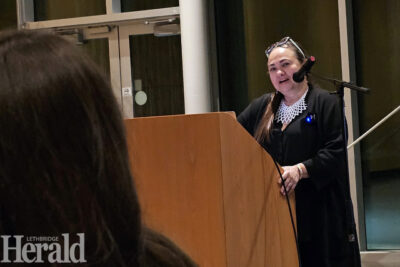Professor shares history of Indigenous CHamoru women during speakers series at Galt Museum
By Theodora MacLeod - Lethbridge Herald Local Journalism Initiative Reporter on November 2, 2023.
 Herald Photo by Theodora MacLeod
Associate Professor of American Indian Studies at the University of Minnesota, Tina Taitano DeLisle, speaking at the Galt museum as part of Indigenous Radically's Indigenous Women Speakers Series.
Herald Photo by Theodora MacLeod
Associate Professor of American Indian Studies at the University of Minnesota, Tina Taitano DeLisle, speaking at the Galt museum as part of Indigenous Radically's Indigenous Women Speakers Series.As part of their Indigenous Women Speakers Series, Indigenous Radically welcomed Tina Taitano DeLisle, Associate Professor of American Indian Studies at the University of Minnesota last week at the Galt Museum.
In a lecture titled Placental Politics: Rewriting Oceanic Histories of Embodied Land Work, Radical Relationalities, and Indigenous Feminisms, Taitano DeLisle spoke on the history of Indigenous CHamoru women in Guam during the early 20th century as the United States Navy took authority over the area.
Referred to by Indigenous residents as Guåhan, it was the first of Oceania to be colonized by Europe when it was taken by Spain. After more than three centuries under Spanish rule, the island was transferred to the United States in 1898 as part of the Treaty of Paris.
According to Taitano DeLisle, most history texts have depicted CHamoru women as nameless objects of Spanish conflict, conversion, and conquest, or in the case of Guam, assimilated subjects under American colonial modernity. Having been born and raised in GuÃ¥han, Taitano DeLisle offers a perspective that has been largely excluded from North American perceptions of Guam’s history.
The research featured in the lecture, which also appears in her book, Placental Politics: Hamoru Women, White Womanhood, and Indigeneity Under U.S. Colonialism in Guam, focuses mainly on the experiences and role of Indigenous nurse-midwives under Navy rule.
In an effort to restructure CHamoru society, the U.S Navy began requiring midwives to be licensed and undergo formal training offered only in English. This pushed out the older women who were practicing as lay midwives (and only had informal education), which the Navy did intentionally because it felt younger women were more trainable. Though the younger midwives adopted American processes and ideas of hygiene, they also incorporated traditional knowledge and rituals that had been passed down through generations of women.
Throughout Taitano DeLisle’s talk, the idea of gendered landscapes arises repeatedly both in relation to the U.S Navy, and CHamoru society. She explains that throughout the oral histories she cited, there was a reoccurring stigma against the young midwives, largely from the older generations of CHamoru women and people who felt the midwives were promiscuous and setting themselves up to be assaulted by working with men in the corps.
She explains that the midwives had to work within the system created by the U.S Navy, however their dedication to tradition and ritual was not eradicated.
“Midwives would refuse the Navy’s orders to burn or discard the baby’s placenta,” Taitano DeLisle said. “This they did under the Navy’s radar. It might seem really trivial that they didn’t listen to the navy.”
She said the midwives would then partake in the traditional practice of burying the placenta to connect the baby to the land. It was believed this practice would protect the infant throughout its life.
An engaging lecture, that allowed attendees a glimpse into Indigeneity as it refers to the experiences of CHamoru women, Taitano DeLisle presented her immense knowledge with great versatility.
Indigenous Radically will be hosting Seminole-Muscogee-Navajo photographer and museum curator, Hulleah Tsinhnahjinnie on Nov. 30 for her lecture, Imaging Ourselves: Portraits & Moments. The event will also take place at the Galt Museum from 6-8 pm.
All ages are welcome and the lectures are offered free of charge.
14-13




